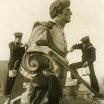HOLIDAY DONATION DRIVE - SUPPORT MSW - DO YOUR PART TO KEEP THIS GREAT FORUM GOING! (Only 51 donations so far out of 49,000 members - C'mon guys!)
×
-
Posts
841 -
Joined
-
Last visited
Reputation Activity
-
 michaelpsutton2 got a reaction from GaryKap in Coppering the USS Hartford in 1899
michaelpsutton2 got a reaction from GaryKap in Coppering the USS Hartford in 1899
A very neat pic of the coppering on an 19th century wooden warship
www.navsource.org/archives/09/46/094601344.jpg
-
 michaelpsutton2 got a reaction from Canute in Hms bounty mast rake
michaelpsutton2 got a reaction from Canute in Hms bounty mast rake
jbshan is 100% correct. Take the original admiralty draught he has posted and measure the angle carefully with a decent drafting protactor.
You can use that plan to confirm and correct any number of small details and make your model just a touch more accurate.
All of the sudden with no warning you are kit bashing!
-
 michaelpsutton2 got a reaction from mtaylor in Hms bounty mast rake
michaelpsutton2 got a reaction from mtaylor in Hms bounty mast rake
jbshan is 100% correct. Take the original admiralty draught he has posted and measure the angle carefully with a decent drafting protactor.
You can use that plan to confirm and correct any number of small details and make your model just a touch more accurate.
All of the sudden with no warning you are kit bashing!
-
 michaelpsutton2 reacted to jbshan in Hms bounty mast rake
michaelpsutton2 reacted to jbshan in Hms bounty mast rake
In general, the foremast, main mast and mizzen were raked in a splayed manner. The fore was raked either forward or vertical, the main a bit aft of that and the mizzen aft of the main. This changed over time. Later ships had less difference. Check the angles very carefully as the 'look' of the model is dependent on the rake of the masts.
-
 michaelpsutton2 got a reaction from Canute in Fife designed yacht "Kentra" being coppered
michaelpsutton2 got a reaction from Canute in Fife designed yacht "Kentra" being coppered
We see a lot of models that have been coppered, but there are so few in real life these days
The classic yacht Kentra underwent a magnificent restoration at Fairlie yachts. She had her bottom coppered in the old traditional way. Can you just imagine the cost.
-
 michaelpsutton2 got a reaction from GuntherMT in Fife designed yacht "Kentra" being coppered
michaelpsutton2 got a reaction from GuntherMT in Fife designed yacht "Kentra" being coppered
We see a lot of models that have been coppered, but there are so few in real life these days
The classic yacht Kentra underwent a magnificent restoration at Fairlie yachts. She had her bottom coppered in the old traditional way. Can you just imagine the cost.
-
 michaelpsutton2 got a reaction from dgbot in Fife designed yacht "Kentra" being coppered
michaelpsutton2 got a reaction from dgbot in Fife designed yacht "Kentra" being coppered
We see a lot of models that have been coppered, but there are so few in real life these days
The classic yacht Kentra underwent a magnificent restoration at Fairlie yachts. She had her bottom coppered in the old traditional way. Can you just imagine the cost.
-
 michaelpsutton2 got a reaction from mtaylor in Fife designed yacht "Kentra" being coppered
michaelpsutton2 got a reaction from mtaylor in Fife designed yacht "Kentra" being coppered
We see a lot of models that have been coppered, but there are so few in real life these days
The classic yacht Kentra underwent a magnificent restoration at Fairlie yachts. She had her bottom coppered in the old traditional way. Can you just imagine the cost.
-
 michaelpsutton2 got a reaction from avsjerome2003 in Fife designed yacht "Kentra" being coppered
michaelpsutton2 got a reaction from avsjerome2003 in Fife designed yacht "Kentra" being coppered
We see a lot of models that have been coppered, but there are so few in real life these days
The classic yacht Kentra underwent a magnificent restoration at Fairlie yachts. She had her bottom coppered in the old traditional way. Can you just imagine the cost.
-
 michaelpsutton2 got a reaction from keelhauled in Are bolt ropes/earrings served?
michaelpsutton2 got a reaction from keelhauled in Are bolt ropes/earrings served?
The illustrations in Steel's 1794 seem to show the bolt robes served for a couple of feet either side of the thimbles
-
 michaelpsutton2 got a reaction from mtaylor in HMS Victory
michaelpsutton2 got a reaction from mtaylor in HMS Victory
If you want to do just a bit of kit bashing, the summer 2015 issue of the Nautical Research Journal has a nice article on her appearance at Trafalgar.
However, It makes no mention of pink gunport strakes.
-
 michaelpsutton2 got a reaction from Laurence_B in "British Royal Yachts: a complete illustrated history"
michaelpsutton2 got a reaction from Laurence_B in "British Royal Yachts: a complete illustrated history"
Just got my copy from Amazon.
Large format 10.5" BY 10.5"
340 pages
Lots of big really clear pic's some in full color
A number of original draughts .I like the fact that the author has not gone the route of using redrawn plans.
I ordered a "used like new" copy and it was less than $30 including shipping. Dirt cheap compared to the price of some books.
This book covers all of the English royal yachts from the Stuarts through today. It's well organized and clearly written. The volume makes it possible for me to untangle the 19 different yachts named "Mary" .
And best of all (one of my pet peeves) they have arranged the pages so that the pictures and the plans don't attempt to straddle the gutter in the center of the pages. You can actually see the whole thing.
The pictures and the plans are so well done that it made me want to sit down and start work on a yacht right now
This one is a keeper and I highly recommend it.
-
 michaelpsutton2 got a reaction from druxey in HDMS FREYA 1789 by minimini - scale 1:48 - 40-gun Danish frigate
michaelpsutton2 got a reaction from druxey in HDMS FREYA 1789 by minimini - scale 1:48 - 40-gun Danish frigate
I really enjoy seeing someone reach into the archives at some museum ad bring one to life. Will she be fully rigged and if so I imagine Karl Marquardts "18th Centruy Rigs & Rigging will be handy.
-
 michaelpsutton2 got a reaction from mtaylor in American sailing warships with no plans or records
michaelpsutton2 got a reaction from mtaylor in American sailing warships with no plans or records
Just screen shot. If this is considered illegal or unethical please remove the post or ask me to do it
-
 michaelpsutton2 got a reaction from Canute in American sailing warships with no plans or records
michaelpsutton2 got a reaction from Canute in American sailing warships with no plans or records
Just screen shot. If this is considered illegal or unethical please remove the post or ask me to do it
-
 michaelpsutton2 got a reaction from uss frolick in American sailing warships with no plans or records
michaelpsutton2 got a reaction from uss frolick in American sailing warships with no plans or records
Just screen shot. If this is considered illegal or unethical please remove the post or ask me to do it
-
 michaelpsutton2 got a reaction from Jorge Diaz O in Ship rigging book
michaelpsutton2 got a reaction from Jorge Diaz O in Ship rigging book
I am surprised no one has mentioned "Masting & Rigging the Clipper Ship & Ocean Carrier" by Harold Underhill
-
 michaelpsutton2 got a reaction from EricWilliamMarshall in What are your most interesting and/or useful books
michaelpsutton2 got a reaction from EricWilliamMarshall in What are your most interesting and/or useful books
I still have a great fondness for the works of Basil Lubbock: The Last of the Windjammers, The Colonial Clippers, The Tea Clippers, The Downeasters, The Western Ocean Packets, The Nitrate Clippers.
Harold Underhill: Deepwater Sail,, Sail Training Ships, Masting & Rigging the Ocean Carrier.
H I Chapelle, D R McGregor, Basil Greenhill, David Lyon, Brian Lavery, Rif Winfield, Robert Gardiner
But far and away I still remember a day over 40 years ago. It was about midnight on a Tuesday and the the library was almost deserted. I was looking for a book on Revolutionary War Naval History for a college course and I came across a crumbling copy of the illustrated catalog for the Henry H Rodgers collection of models at Annapolis. I didn't know models like this existed. I sat on the floor of the aisle deep in the stacks of the Howard Tilton Librabry of Tulane University slowly going from one model to the next. In 15 minutes I developed a fixation that continues to this very day.
I own a copy now and take it off the shelf when the work is not going the way I know that it should. I tell myself that one day I will learn to do work like that.
-
 michaelpsutton2 got a reaction from druxey in Seeking information on determining load waterline
michaelpsutton2 got a reaction from druxey in Seeking information on determining load waterline
Tonight, I have spent a little time looking at a number of plans from the NMM website of ships from the latter half of the 1700's. The majority seem to indicate a load waterline.
On an awful lot of them the load waterline is parallel to a line drawn between the lower edges of the first and last ports of the lowest gun deck. It is set so that it is very near to the lower edge of the main wale at it's lowest point. On some ships it may be slightly above or below that spot . An example shown below is the 3rd rate HMS Alfred of 1778. It might be said to be a good representative of most but not all the draughts of this period.
The question though becomes .....were these ship designed in advance to float at this level or was the line arbitrarily placed on the plans in this position simply as a formality.
One reads time and time again that there was difficulty with getting the lower deck guns high enough out of the water.The plans show plenty of freeboard.
Maybe the ships were designed to use these waterlines but their captains overloaded them.
Somebody with access to more of the archives than myself might compile a list of how much water the vessals were known to have drawn. This could be compared to the plans.
Obviously the ships rose and fell with the amount of supplies ballast etc.
-
 michaelpsutton2 got a reaction from avsjerome2003 in Seeking information on determining load waterline
michaelpsutton2 got a reaction from avsjerome2003 in Seeking information on determining load waterline
Mathew Bakers famous sail plan for a galleon of 1596 seems to show where he wanted her to float. The earliest named plan in the NMM the Tryumph of 1698 has a load line indicated
-
 michaelpsutton2 got a reaction from druxey in Seeking information on determining load waterline
michaelpsutton2 got a reaction from druxey in Seeking information on determining load waterline
All of the old methods produced rough approximations. Some were rougher than others. Shipbuilding was an art not a science until the middle of the eighteenth century.The ships were built to displace something more than the actual weight of their intended contents and could then be ballasted down the design load water line for stability. If you want a snapshot of just how well this worked in the real world, consult "Great ships" by Frank Fox. See how many of the ships, particularly the 1st, 2nd, & 3rd rates required girdling or padding the frames to increase the displacement. So many ships could hardly open the lower tier ports when they were at anchor much less at sea.
This subject interests me and I would love a chance to read the paper when you are done
-
 michaelpsutton2 reacted to Chuck in HM Cutter Cheerful 1806 by Chuck - FINISHED - 1:48 scale - kit prototype
michaelpsutton2 reacted to Chuck in HM Cutter Cheerful 1806 by Chuck - FINISHED - 1:48 scale - kit prototype
Correct!!! Bottom of ports follow the run of the deck. Sides are vertical and straight with teh frames. Port lids will be the same. Typical mistake seen on kits. Not all ports are completely square at all. Take a look at this original draft. The red dashed square is at right angles. Note how the port is not. It follows the deck.
-
 michaelpsutton2 got a reaction from CaptainSteve in Mutiny on the Bounty
michaelpsutton2 got a reaction from CaptainSteve in Mutiny on the Bounty
Great point "Weather clothes" could have interfered with the use of oars..........
-
 michaelpsutton2 got a reaction from trippwj in Dutch Warships in the Age of Sail, 1600-1714: Design, Construction, Careers, and Fates
michaelpsutton2 got a reaction from trippwj in Dutch Warships in the Age of Sail, 1600-1714: Design, Construction, Careers, and Fates
Just rec'd my copy of this book by James Bender. This volume is very similar to the four volume series British Warships in the" Age of Sail".
There are listings for all of the major Dutch warships of the period. There are pleny of Van de Velde drawings and paintings. Unfortunately there are only a couple of plans because the Dutch did not use plans in the way that the English did.
The book will make a fine addition to my bookshelf and the introductory price on Amazon is more than fair.
I had hoped for a little more information on Dutch rigging and fitting practices though. I don't have nearly the same quality of sources as I do for English ships.
-
 michaelpsutton2 got a reaction from trippwj in Seeking information on determining load waterline
michaelpsutton2 got a reaction from trippwj in Seeking information on determining load waterline
Tonight, I have spent a little time looking at a number of plans from the NMM website of ships from the latter half of the 1700's. The majority seem to indicate a load waterline.
On an awful lot of them the load waterline is parallel to a line drawn between the lower edges of the first and last ports of the lowest gun deck. It is set so that it is very near to the lower edge of the main wale at it's lowest point. On some ships it may be slightly above or below that spot . An example shown below is the 3rd rate HMS Alfred of 1778. It might be said to be a good representative of most but not all the draughts of this period.
The question though becomes .....were these ship designed in advance to float at this level or was the line arbitrarily placed on the plans in this position simply as a formality.
One reads time and time again that there was difficulty with getting the lower deck guns high enough out of the water.The plans show plenty of freeboard.
Maybe the ships were designed to use these waterlines but their captains overloaded them.
Somebody with access to more of the archives than myself might compile a list of how much water the vessals were known to have drawn. This could be compared to the plans.
Obviously the ships rose and fell with the amount of supplies ballast etc.












.thumb.jpeg.fc5d633a7b34428fcf19419a73d56d55.jpeg)

